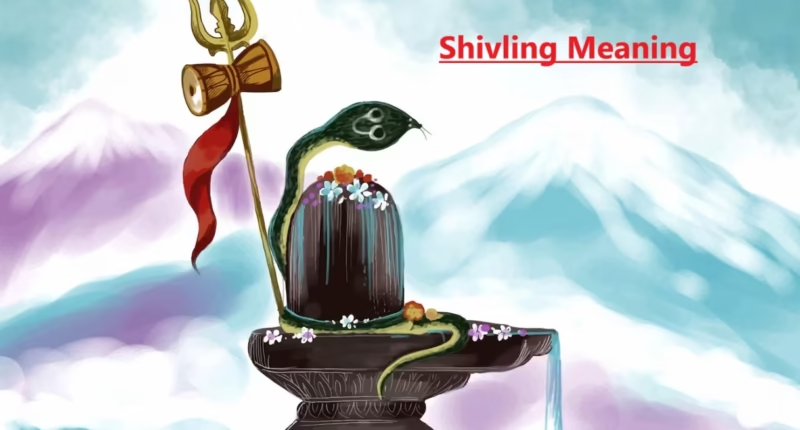The Shivling, also known as Shiva Lingam, is one of the most revered symbols in Hinduism, representing Lord Shiva, the Supreme God of transformation and destruction. The Shivling meaning goes far beyond a simple religious idol it’s a powerful symbol of cosmic energy, spiritual potential, and philosophical depth. In this article, we will explore the meaning of Shivling, its types, symbolism, scientific interpretation, and its role in Hindu rituals.
1. What is Shivling?
The Shivling is a cylindrical or oval-shaped object often placed on a circular base called the Yoni. The Lingam represents Lord Shiva, while the Yoni symbolizes Shakti (the divine feminine power). Together, they symbolize the union of the masculine and feminine energies of the universe.
2. Shivling Meaning in Hinduism
In Hindu philosophy, the Shivling meaning is not just a representation of God in form but also of the formless (Nirakar). It signifies the eternal reality, beyond birth and death, creation and destruction. The word “Lingam” in Sanskrit means “symbol” or “mark,” hence the Shivling is the mark of Shiva, signifying his presence.
-
It is believed to be the source of all existence.
-
The three parts of the Shivling represent the Trinity: Creation (Brahma), Preservation (Vishnu), and Destruction (Shiva).
3. The Symbolism Behind the Shivling
The symbolism of the Shivling is rich with metaphysical and spiritual meaning:
-
Vertical Cylinder (Lingam): Represents purusha, the masculine energy or consciousness.
-
Circular Base (Yoni): Symbolizes prakriti, the feminine creative energy or nature.
-
Together, they represent the balance of dualities—the union of energy and consciousness, the cosmic creation and dissolution process.
This is why the Shivling meaning is deeply connected with the creation of the universe, and it is seen as the source of all cosmic energy.
4. Mythological Stories Related to Shivling
There are several stories in Hindu mythology explaining the origin and Shivling meaning.
The Infinite Pillar of Fire
One of the most famous stories is from the Linga Purana, where Lord Vishnu and Lord Brahma argued over who was supreme. Suddenly, a massive pillar of fire appeared. Both tried to find the end—Brahma went upwards, Vishnu downwards—but neither could. This endless pillar was Lord Shiva in the form of a Lingam, showing his boundless nature.
5. Scientific Perspective on Shivling

While the Shivling is steeped in religious and mythological symbolism, some scientists and scholars have tried to decode the Shivling meaning scientifically.
-
The elliptical shape of the Shivling is said to represent a black hole or cosmic energy center.
-
Ancient temples with Shivlings are often located in spots with high geomagnetic energy, making them centers for meditation and healing.
-
The act of pouring water or milk on a Shivling is believed to regulate body temperature and promote mental calmness.
Thus, from a scientific angle, the Shivling can be viewed as a symbol of energy and equilibrium.
6. Types of Shivlings
There are several types of Shivlings found across India, each with its own unique meaning and purpose:
1. Jyotirlingas
These are 12 sacred shrines across India where Shiva is worshipped in the form of light (Jyoti). Some of them include:
-
Kedarnath
-
Somnath
-
Kashi Vishwanath
-
Rameshwaram
2. Banalinga
Naturally found in the Narmada River, these smooth, egg-shaped stones are considered very powerful and can be kept at home.
3. Parad Shivling (Mercury Shivling)
Made of purified mercury, it is believed to have healing properties and represents high spiritual energy.
4. Ek Mukhi, Panch Mukhi, Dwi Mukhi Shivlings
These are symbolic representations with one, two, or five faces of Lord Shiva on the Shivling.
Each type enhances different spiritual vibrations, and knowing their Shivling meaning helps in choosing the right one for personal or temple use.
7. Importance of Worshipping Shivling
Worshipping the Shivling is believed to:
-
Destroy sins and cleanse karma.
-
Bring peace, prosperity, and mental strength.
-
Help attain moksha (liberation).
-
Balance male and female energies in life.
-
Activate chakras when worshipped through mantras and meditation.
Devotees often chant “Om Namah Shivaya” while offering water, milk, honey, and bilva leaves to the Shivling, understanding its meaning as a symbol of divine consciousness.
8. How to Worship a Shivling
Worshipping the Shivling follows a simple but powerful ritual:
-
Wake up early, bathe, and wear clean clothes.
-
Place the Shivling on a clean altar.
-
Offer water or milk while chanting Shiva mantras.
-
Decorate with Bilva Patra, flowers, and sandalwood paste.
-
Light a lamp and incense.
-
Meditate for a few minutes, focusing on Lord Shiva’s form.
Understanding the Shivling meaning can deepen the spiritual connection during worship.
9. Shivling in Temples vs. Home
While large Shivlings are usually seen in temples, small Shivlings can be kept at home. However, some rules must be followed:
-
Parthiv Shivling (made of clay or mud) can be used for temporary worship.
-
Banalinga is ideal for home worship.
-
Abhishek (ritual bath) should be done regularly.
-
The Shivling should be placed facing North, and the Yoni base should face East.
Maintaining purity and discipline is important when keeping a Shivling at home.
10. Misconceptions About the Shivling
Many people misunderstand the Shivling as a symbol of sexuality due to its shape. This is a deeply flawed interpretation rooted in ignorance.
-
The Lingam-Yoni union is spiritual, not physical.
-
It represents cosmic creation, not human reproduction.
-
The shape is symbolic of infinity and energy, not anatomy.
Understanding the true Shivling meaning helps us rise above such misconceptions and appreciate its spiritual essence.
11. Shivling Meaning in Spiritual Practices
In yogic and tantric practices, the Shivling represents the awakening of consciousness.
-
It is linked with the Ajna Chakra (third eye).
-
The cylindrical form represents Kundalini energy rising.
-
Meditating upon the Shivling helps in gaining inner clarity, peace, and enlightenment.
In advanced spiritual circles, the Shivling is viewed as a symbol of formless awareness the witness of all creation.
Frequently Asked Questions (FAQs)
Q1. Can we keep a Shivling at home?
Yes, small-sized Banalinga or Parad Shivling can be kept at home, provided proper rituals and cleanliness are maintained.
Q2. What does pouring water on Shivling mean?
It represents cooling the cosmic fire of Lord Shiva’s energy and washing away our karmic impurities.
Q3. Is Shivling a sexual symbol?
No. The Shivling represents divine cosmic creation and the balance of masculine and feminine energies, not sexual union.
Q4. What is the best mantra for Shivling worship?
“Om Namah Shivaya” and “Mahamrityunjaya Mantra” are the most powerful mantras to chant during worship.
Conclusion
The Shivling is more than just a religious icon; it is a symbol of limitless energy, supreme consciousness, and spiritual wisdom. Whether viewed from a religious, philosophical, or scientific perspective, the Shivling meaning embodies the ultimate truth of the universe that all existence is born from one divine source.
Worshipping the Shivling with devotion, knowledge, and understanding can transform your life, bringing inner peace, spiritual awakening, and divine blessings.






